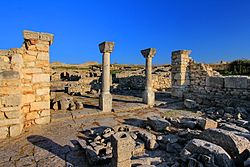Bylis (in Albanian) Βύλλις or Βουλλίς (in Greek) | |
 Ruins of Bylis | |
| Location | Hekal, Fier County, Albania |
|---|---|
| Region | Illyria |
| Coordinates | 40°32′25″N 19°44′15″E / 40.54028°N 19.73750°E |
| Type | Settlement |
| History | |
| Periods |
|
| Cultures |
|
| Site notes | |
| Excavation dates | 1978–1991 2000–present |
| Archaeologists | |
| Ownership | Public |

Byllis (Albanian: Bylis; Greek: Βύλλις; Latin: Byllis) or Bullis or Boullis (Βουλλίς) was an ancient city and the chief settlement of the Illyrian tribe of the Bylliones,[1][2] traditionally located in southern Illyria. In Hellenistic times the city was either part of Illyria or Epirus. In Roman times it was included within Epirus Nova, in the province of Macedonia.[3][4][5][6][7][8] The remains of Byllis are situated north-east of Vlorë, 25 kilometers from the sea in Hekal, Fier County, Albania. Byllis was designated as an archaeological park on 7 April 2003 by the government of Albania.[9]
The massive walls of Byllis were built around 350 BC when the Illyrians went through a dynamic development founding their own cities. The urban settlement was built on the territory of the community of the Bylliones on an already existent Illyrian hilltop proto-urban area dating back to the previous century.[10] Later Byllis acquired the trappings of a Hellenistic town,[11] and because the southernmost Illyrian tribes, including the Bylliones, were inclined to become bilingual, it was also a Greek-speaking city.[12] Byllis received sacred ancient Greek envoys, known as theoroi, during the early 2nd century BC, which only cities that were considered Greek were eligible to receive.[13] The time duration that passed before Illyrian cities were documented on a list of theorodokoi clarifies that acculturation did take place in southern Illyria, however it indicates that the process was gradual.[14]
During the Roman-Illyrian war in 169/168 BC the Bylliones took part on the Roman side against the Illyrian king Gentius. However, the subsequent alliance of Byllis with Molossians and Macedonians led to its sacking and destruction by the Romans. After a long decline, in 30 BC the city became a Roman colony. In Roman times Byllis rose again, also becoming a bishopric in late antiquity.[15]
- ^ Lippert & Matzinger 2021, pp. 101–102: "Das Koinon der Byllionen hatte ihren Hauptsitz in Byllis rund 5 km nordöst-lich von Nikaia und ebenfalls am rechten Ufer der Vjosa (> Abb. 30). Die Stadt wurde urn 350 v. Chr. auf einem steilen Hügel angelegt und umfasste eine Fläche von 30 ha."
- ^ Belli Pasqua 2014, p. 427: "Fondata intorno alla metà del IV a.C. in una zona già sede di abitati protourbani risalenti al secolo precedente, Byllis fu la sede principale della comunità territoriale dei Bylliones, della quale sono stati individuati numerosi centri, dislocati sulle colline che delimitano la valle del fiume Vjosa."
- ^ Hoti 2022, pp. 245, 249
- ^ Jaupaj 2019, p. 86
- ^ Hatzopoulos, Miltiades B. (23 November 2020). Ancient Macedonia. Walter de Gruyter GmbH & Co KG. p. 212. ISBN 978-3-11-071868-3.
Byllis, city on the border between Illyria and Epirus
- ^ Abdy, Richard Anthony (2007). Roman Butrint: An Assessment. Oxbow Books for the Butrint Foundation. p. 190. ISBN 978-1-84217-234-6.
the Caesarean colony at Corinth, and possible Caesarean colonies at Dyme and Byllis, represent the most obvious impact of Roman settlement in Epirus and Achaea .
- ^ Marzano, Annalisa; Métraux, Guy P. R. (30 April 2018). The Roman Villa in the Mediterranean Basin: Late Republic to Late Antiquity. Cambridge University Press. p. 271. ISBN 978-1-316-73254-0.
Byllis (Epirus)
- ^ Hodges, Richard (2000). Towns and Trade in the Age of Charlemagne. Bloomsbury Academic. p. 42. ISBN 978-0-7156-2965-9.
The great curtain walls at Butrint, in common with the refortification of other cities in Epirus such as Byllis
- ^ Tusa, Sebastiano. "Menaxhimi Fiskal dhe Struktura Drejtuese e Sistemit të Parqeve Arkeologjike në Shqipëri në vëmendje të veçantë: Parqet Arkeologjike: Apolloni dhe Antigone" (PDF) (in Albanian). United Nations Educational, Scientific and Cultural Organization (UNESCO). p. 8. Archived from the original (PDF) on 22 November 2020. Retrieved 23 November 2020.
- ^ Winnifrith 2002, p. 58; Belli Pasqua 2014, p. 427; Hodges 2021, p. 1; Lippert & Matzinger 2021, pp. 78, 101–102; Fiedler et al. 2021, p. 137.
- ^ Winnifrith 2002, p. 58: "There are however, some other sites in Southern Albania which cannot be attributed to sudden Macedonian or Molossian advance, notably Amantia, Byllis and Selce, thought by some to be Pelium, where Alexander the Great fought a difficult campaign. Their massive walls were constructed before the end of the fourth century, and the literary sources talk of them as Illyrian rather than Epirote or Macedonian foundations. Later Amantia and Byllis acquired the trappings of a Hellenistic town."
- ^ Cite error: The named reference
Hammond37was invoked but never defined (see the help page). - ^ Peter Allan Hansen. Carmina epigraphica Graeca. Novus Eboracus, 1983. ISBN 978-3-11-008387-3, p. 295: "Sacred envoys from Greek sanctuaries visited Greek cities only: Dyrrachium, Apollonia, Oricum, Amantia and Byllis (BCH 45 [1921], 1f.), from which it appears that Byllis was a Greek city, founded probably by Pyrrhus, or that its citizens, the Byllideis, had become Greek-speaking.".
- ^ Cite error: The named reference
Stocker309was invoked but never defined (see the help page). - ^ Lippert & Matzinger 2021, p. 101.
